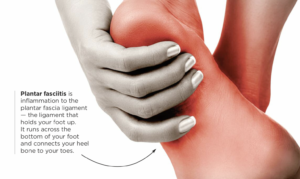What to Know About Plantar Fasciitis
 Everyone likes to put their best foot forward, but that’s tough to do when your feet are in pain. To deal with the issue, you try to find the most comfortable shoes possible – soft and cushy – to make the pain go away. If your problem is plantar fasciitis, you just made the problem worse. “Probably the most common mistake I see is not getting, or keeping, adequate stability,” explained Eddie Davis, doctor of podiatric medicine, fellow of the American College of Foot and Ankle Surgery. Davis, who is board certified in foot surgery by the American Board of Foot and Ankle Surgery, practices at South Texas Podiatrist in San Antonio.
Everyone likes to put their best foot forward, but that’s tough to do when your feet are in pain. To deal with the issue, you try to find the most comfortable shoes possible – soft and cushy – to make the pain go away. If your problem is plantar fasciitis, you just made the problem worse. “Probably the most common mistake I see is not getting, or keeping, adequate stability,” explained Eddie Davis, doctor of podiatric medicine, fellow of the American College of Foot and Ankle Surgery. Davis, who is board certified in foot surgery by the American Board of Foot and Ankle Surgery, practices at South Texas Podiatrist in San Antonio.
“Unfortunately, people like fluffy, colorful, squishy shoes,” noted Davis. “If you’re on your feet and active, they can make your foot a lot worse.” Plantar fasciitis is inflammation to the plantar fascia ligament — the ligament that holds your foot up. It runs across the bottom of your foot and connects your heel bone to your toes. “The fascia gives the foot stability. It doesn’t let the foot collapse,” explained Davis. “But the fascia can be sprained just like any other body part.”
The fascia can also be misused or overused, according to Davis. “Wearing the wrong shoe, overdoing it, a sudden increase in activity, bad form in running – the fascia gets angry, irritated,” explained Davis. Plantar fasciitis symptoms to note include pain at the base of the heel, but a true indicator is what is known as “first step pain.” “If you get out of bed in the morning, take your first step and it’s very painful, that is often plantar fasciitis,” explained Davis. Even with those indicators, Davis notes that not all heel pain is plantar fasciitis.
 So how do you know when heel pain is indeed plantar fasciitis? “If the pain has been persistent – a month or longer – it’s best to get a good diagnosis,” said Davis. That means working with a podiatrist who will take a good history of your activity, occupation and possible fascia stressors, along with a thorough examination. That examination may include a diagnostic ultrasound. “It’s truly the gold standard. With a diagnostic ultrasound, you’re going to see the fascia and everything around it. You can see calcium deposits, ruptures of the fascia, the nerves within the fascia. It’s inexpensive, quick and done right in the office,” explained Davis. “Then you get a correct diagnosis from day one, so we know what to do.”
So how do you know when heel pain is indeed plantar fasciitis? “If the pain has been persistent – a month or longer – it’s best to get a good diagnosis,” said Davis. That means working with a podiatrist who will take a good history of your activity, occupation and possible fascia stressors, along with a thorough examination. That examination may include a diagnostic ultrasound. “It’s truly the gold standard. With a diagnostic ultrasound, you’re going to see the fascia and everything around it. You can see calcium deposits, ruptures of the fascia, the nerves within the fascia. It’s inexpensive, quick and done right in the office,” explained Davis. “Then you get a correct diagnosis from day one, so we know what to do.”
Davis said, “If you don’t have an accurate diagnosis, you’re going to be spending time, energy, effort and money on things that may not bring you to a cure,” he notes. “People get the idea that plantar fasciitis is hard to treat, but it’s really not,” he added. Most treatment is minimally invasive, including orthotics, wearing the correct shoes, or perhaps using manual physical therapy to stretch and lengthen the heel cord. One treatment that Davis cautions against is using cortisone shots to address the pain. He noted that people often focus on the symptoms versus the cause, addressing the pain alone instead of tackling what’s causing the pain. “Cortisone is a double-edged sword,” Davis noted. “Sometimes cortisone shots can do more damage. It essentially breaks tissue down, so if you have damaged tissue, and then you use cortisone, you can actually make it worse.”
Instead, proper diagnosis, treatment and being proactive can keep the issue at bay. “We can cure heel pain close to 100 percent of the time,” he said, “but if there’s a reason why you have it and you ignore those reasons, it’s eventually going to regenerate and come back.” To keep that from happening, proper footwear is a must. “If you’re smart, you’re going to be proactive and you’re going to be very judicious about your footwear,” explained Rob Kaufman, owner of New Balance San Antonio, where staff are trained to help evaluate foot needs and offer suggestions on proper footwear to address issues. People often come to the stores with doctor’s prescriptions for certain shoes. New Balance offers a variety of models well suited to address plantar fasciitis concerns. The stores also offer a fit analysis to help evaluate what you need. “The idea is to keep the fascia from stretching,” explained Kaufman. “Gel might feel good initially, but you’re not getting anywhere as far as treatment. The best shoes feature the right technology that address your particular biomechanics to help mitigate the pain.”
By Dawn Robinette










0 Comments